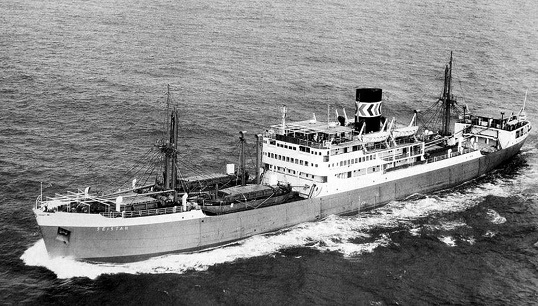Seistan

The build
Built in South Shields by John Readhead & Sons, Seistan was of 145.66m (477.9ft) loa and was powered by a four-cylinder Doxford-type engine. Seistan could produce 4,400bhp driving as single screw and giving a top speed of 13.5 knots.
The explosion of 1958
The 7,440grt Strick Line vessel was less than a year old when it exploded and sank. This resulted in the loss of 57 lives whist at anchor off Sitra Island, Bahrain during a voyage from London to the Persian Gulf.
Seistan was just three weeks into its second voyage when smoke was seen coming from a deck ventilator of the No 5 hold. The cargo included 150 tons of commercial explosives, as well as fuses and detonators. The crew decided to use smothering steam to extinguish the fire.
Seistan diverted to Bahrain and work immediately began to discharge the explosives to barges with attempts to fight the fire occurring at the same time. Almost half the total had been removed when a massive explosion occurred, killing 53 of the 68 British officers and Indian ratings, as well as four crew members from a tug.
Aftermath
A court of inquiry held in London in February 1959 heard that the fire had originated in the lower part of the No 5 hold and was likely to have been the result of spontaneous combustion of a cargo of toe puff – a material impregnated with highly flammable cellulose nitrate solvent and used in the manufacture of boots and shoes.
Barely two months after the Seistan disaster, two fires broke out in a toe puff cargo being carried by another Strick Line ship, Karaghistan, which the crew were able to extinguish.
The Seistan inquiry heard that recommendations on the safe carriage of toe puff were not compulsory and it strongly recommended that the cargo should no longer be allowed to be carried by ships, except on deck, until more research into the risks of spontaneous combustion was completed.
Legacy
In 1959, a meeting of the Nautilus predecessor union Merchant Navy & Airline Officers' Association (MNAOA) debated a motion calling for danger money to be paid to all those serving on merchant ships carrying explosives.
The Union also raised its concerns about the incident with the UK Ministry of Transport, and general secretary Doug Tennant was appointed to an advisory committee established by the UK government to review the rules governing the shipment of dangerous goods and explosives. This body went on to make a substantial input into the development and adoption, in 1965, of the International Maritime Dangerous Goods Code.
Seistan fact file
How big was the Seistan?
The Seistan had a grt of 7,440 with a loa of 145.66m (477.9ft)
When was the Seistan launched?
The Seistan was launched in 1958
How many lives were lost in the explosion?
53 of the 68 British officers and Indian ratings were killed, as well as four crew members from a tug
Contribute
Are you knowledgeable about this vessel?
Submit your contribution to this article to our editorial team.
Write to usView more ships of the past
HMS Beagle
Launched 200 years ago, HMS Beagle has been described as one of the most important ships in history – thanks to the observations on evolution and natural selection that its famous passenger Charles Darwin made during a five-year voyage around the world between 1831 and 1836.
Common.ReadMoreHMS Beagle
Malakand
Launched in November 1918, the Malakand was a sistership to three other vessels and was fitted to train cadets until the shipping slump of the 1920s. With an uneventful early career, the Malakand later became the victim of Liverpool's May Blitz in 1941.
Common.ReadMoreMalakand
Manxman
Over the past century two vessels serving with the Isle of Man Steam Packet Company (IOMSPCo) have borne the name Manxman, with the company's newest ferry – due to enter service in 2023 – set to be the third.
Common.ReadMore